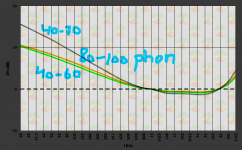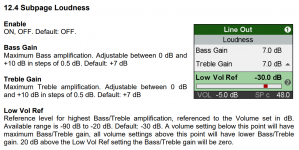Fletcher-Munson Curves - Wikipedia
"The Fletcher–Munson curves are one of many sets of equal-loudness contours for the human ear."
Merlijn van Veen - equal-loudness
This calculator displays equal-loudness contours in accordance with ISO 226:2003. It allows you to normalize to any contour and see relative differences."
This calculater makes it easy to see the difference between 40 phon which correspence to a silent environment and a louder environment like a concerthal.
Equalizer APO download | SourceForge.net
Equalizer APO is a parametric / graphic equalizer for Windows.
add a graphic equaliser and past this text in it:
GraphicEQ: 20 -5; 25 10; 31.5 14; 40 12.8; 50 11.9; 63 10.9; 80 9.5; 100 8.8; 125 7.7; 160 6.6; 200 5.5; 315 3.4; 400 2.4; 500 2; 630 1.5; 800 0.5; 1000 0; 1250 -1.5; 1600 -2; 2000 1.05; 2500 1.065; 3150 -1.5; 4000 -2; 5000 -2; 6300 -1.5; 8000 0.5; 10000 2.5; 12500 4.5; 20000 14
This will give you a nice loudness contour which corresponse to the difference between perceived loudness at 40 and 70 phon.
You can play with different levels of loudness; but to me this 40-70 level sound pleasant with better realistic bassdrum experience.
For my Orions i thought it better to supress the lowest tones of 20 and 25 hz. Be aware of higher woofer excursions.
"The Fletcher–Munson curves are one of many sets of equal-loudness contours for the human ear."
Merlijn van Veen - equal-loudness
This calculator displays equal-loudness contours in accordance with ISO 226:2003. It allows you to normalize to any contour and see relative differences."
This calculater makes it easy to see the difference between 40 phon which correspence to a silent environment and a louder environment like a concerthal.
Equalizer APO download | SourceForge.net
Equalizer APO is a parametric / graphic equalizer for Windows.
add a graphic equaliser and past this text in it:
GraphicEQ: 20 -5; 25 10; 31.5 14; 40 12.8; 50 11.9; 63 10.9; 80 9.5; 100 8.8; 125 7.7; 160 6.6; 200 5.5; 315 3.4; 400 2.4; 500 2; 630 1.5; 800 0.5; 1000 0; 1250 -1.5; 1600 -2; 2000 1.05; 2500 1.065; 3150 -1.5; 4000 -2; 5000 -2; 6300 -1.5; 8000 0.5; 10000 2.5; 12500 4.5; 20000 14
This will give you a nice loudness contour which corresponse to the difference between perceived loudness at 40 and 70 phon.
You can play with different levels of loudness; but to me this 40-70 level sound pleasant with better realistic bassdrum experience.
For my Orions i thought it better to supress the lowest tones of 20 and 25 hz. Be aware of higher woofer excursions.
Last edited:
Only way it will sound realistic is to play at realistic volume.listening at low volume the impact of low frequency sounds like bassdrum is not realistic without some boost
I think it's more about getting a realistic balance across the spectrum at lower volumes, so for instance how does our brain interpret something played at a lower than expected volume, does it sound like it's further away, does it sound like it's smaller, does this for some reason make it sound less realistic?
I've been using the loudness feature on my ADI-2 DAC FS and love it. I'm using this mainly with TV/movies (new house doesn't suit a surround setup, and I have young kids so volume needs to be kept low in the evening).
https://www.rme-audio.de/download/adi2dac_e.pdf
Basically you set a reference level and bass/treble gain at that point. At 20dB above reference the gain of bass/treble is zero. Bass/treble gain is automatically reduced as you increase volume between reference level and 20dB higher.
All settings are made by ear at this point but the impact on voice intelligibility and bass presence is profound (to me). I can switch the feature on and off via the remote, so it's easy to compare.
https://www.rme-audio.de/download/adi2dac_e.pdf
Basically you set a reference level and bass/treble gain at that point. At 20dB above reference the gain of bass/treble is zero. Bass/treble gain is automatically reduced as you increase volume between reference level and 20dB higher.
All settings are made by ear at this point but the impact on voice intelligibility and bass presence is profound (to me). I can switch the feature on and off via the remote, so it's easy to compare.
Attachments
Hi,
I have trouble with these curves. On my system, it appears that past 90-95dBC, SPL increases more for medium/high frequencies than others. My listening room is very dead (RT60 = 170ms for a room volume of 100m^3). I have to use a flat frequency with bass shelve +6dB for 80-90dBC playback, but a slope of -6dB in the upper part of the spectrum for 95-100dBC playback.
My perception disagree with isosonic curves, I'd like to know if you feel the same or not ?
I have trouble with these curves. On my system, it appears that past 90-95dBC, SPL increases more for medium/high frequencies than others. My listening room is very dead (RT60 = 170ms for a room volume of 100m^3). I have to use a flat frequency with bass shelve +6dB for 80-90dBC playback, but a slope of -6dB in the upper part of the spectrum for 95-100dBC playback.
My perception disagree with isosonic curves, I'd like to know if you feel the same or not ?
- Status
- This old topic is closed. If you want to reopen this topic, contact a moderator using the "Report Post" button.
- Home
- Design & Build
- Software Tools
- Equal Loudness

